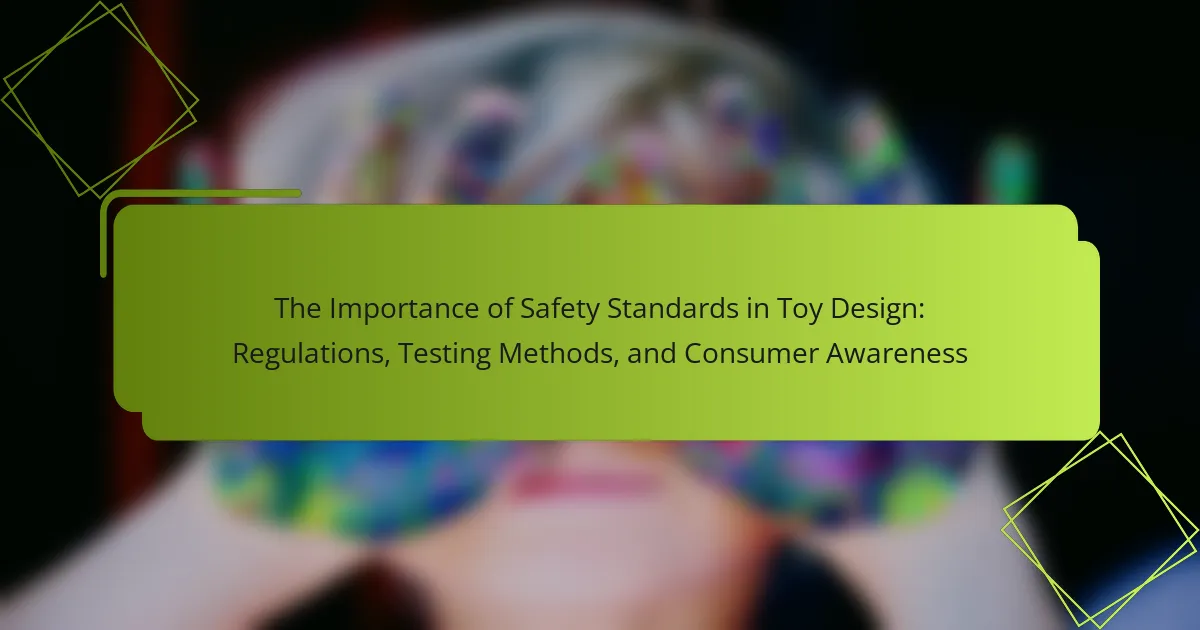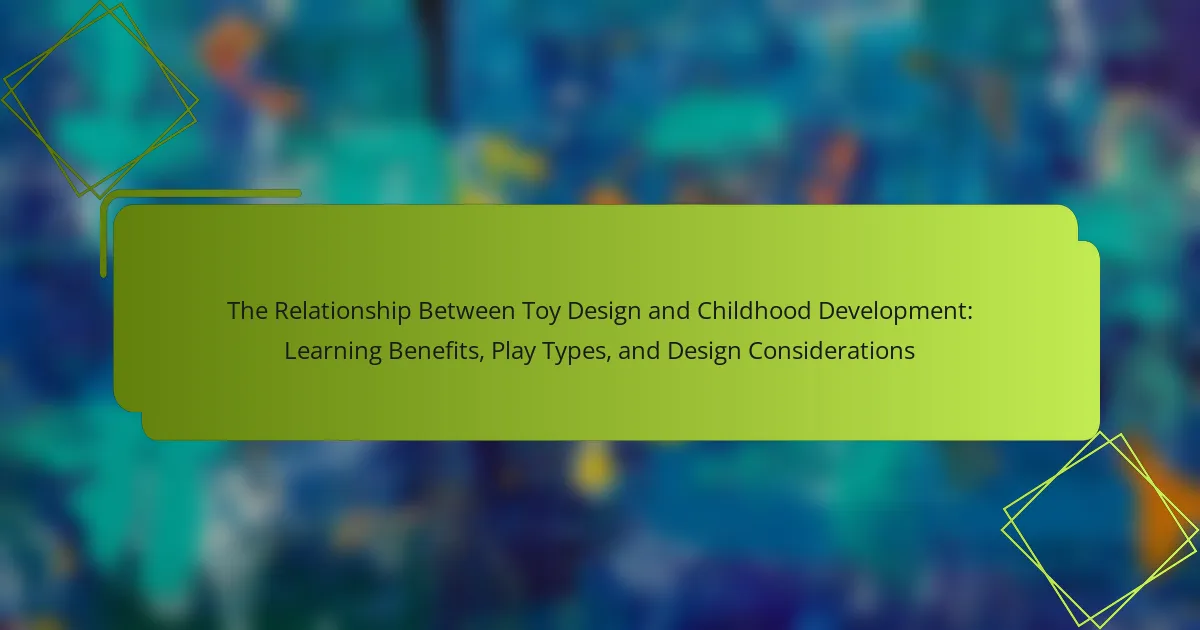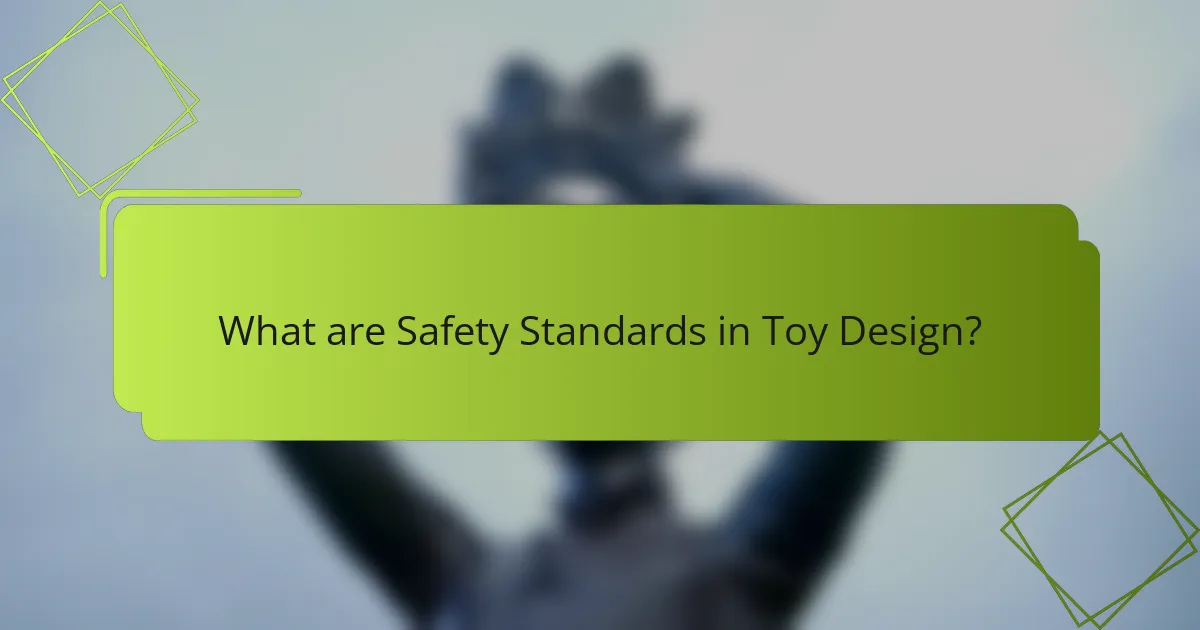
What are Safety Standards in Toy Design?
Safety standards in toy design are regulations that ensure toys are safe for children to use. These standards address potential hazards such as choking, sharp edges, and toxic materials. Organizations like ASTM International and the Consumer Product Safety Commission (CPSC) establish these guidelines. Compliance with safety standards requires rigorous testing and certification processes. For example, toys must undergo assessments for mechanical and physical properties. They are also evaluated for flammability and chemical content. Adhering to these standards helps prevent injuries and ensures consumer trust. In 2020, the CPSC reported over 200,000 toy-related injuries in the U.S., highlighting the importance of these safety measures.
Why are Safety Standards Crucial for Toy Design?
Safety standards are crucial for toy design to ensure the protection of children. These standards minimize risks of injury and hazards associated with toys. According to the U.S. Consumer Product Safety Commission, toys are responsible for thousands of injuries annually. Compliance with safety standards helps manufacturers avoid legal liabilities. It also builds consumer trust in the safety of toys. Furthermore, safety testing verifies that toys meet established guidelines. This process includes assessments for choking hazards, toxic materials, and sharp edges. Adhering to safety standards ultimately promotes healthier play environments for children.
What risks do toys pose to children without safety standards?
Toys without safety standards pose significant risks to children. These toys may contain hazardous materials, such as lead or phthalates, which can cause serious health issues. Choking hazards are prevalent in poorly designed toys, especially those with small parts. Toys may also have sharp edges or points that can result in cuts or injuries. Inadequate labeling can lead to misuse, increasing the risk of accidents. A report from the U.S. Consumer Product Safety Commission indicates that unsafe toys contribute to thousands of injuries annually. Thus, the absence of safety standards greatly endangers children’s well-being.
How do safety standards protect consumers?
Safety standards protect consumers by ensuring products meet minimum safety requirements. These standards are established by regulatory bodies to prevent hazards. They cover aspects like materials used, design, and manufacturing processes. Compliance with safety standards reduces the risk of injury or harm. For example, toys must not contain toxic substances or sharp edges. Regular testing and certification are required to verify adherence to these standards. This process helps identify potential risks before products reach the market. Ultimately, safety standards build consumer trust and promote safer product choices.
What are the Key Components of Safety Standards?
Key components of safety standards include regulatory compliance, testing procedures, labeling requirements, and risk assessment. Regulatory compliance ensures adherence to laws and guidelines governing product safety. Testing procedures involve evaluating toys for hazards such as choking, sharp edges, and toxic materials. Labeling requirements mandate clear information about age appropriateness and safety warnings. Risk assessment identifies and mitigates potential dangers associated with toy use. These components collectively ensure that toys are safe for consumers, particularly children.
What types of regulations govern toy safety?
Toy safety is governed by various regulations that ensure products are safe for children. In the United States, the Consumer Product Safety Commission (CPSC) enforces safety standards for toys. The ASTM F963 is a widely recognized standard that outlines safety requirements for toys. In Europe, the EN 71 standard specifies safety aspects for toys sold in the European Union. These regulations cover aspects such as choking hazards, toxic substances, and mechanical safety. Compliance with these standards is mandatory for manufacturers. Non-compliance can lead to recalls and legal penalties. These regulations are crucial for protecting children’s safety and well-being.
How do these regulations differ across countries?
Regulations for toy safety differ significantly across countries. In the United States, the Consumer Product Safety Commission (CPSC) enforces strict regulations under the Consumer Product Safety Improvement Act (CPSIA). This includes mandatory testing for lead and phthalates in toys. In contrast, the European Union implements the EN71 standard, which emphasizes safety through risk assessment and compliance testing. Countries like Canada follow the Canada Consumer Product Safety Act, which mandates similar safety standards but may differ in specific chemical limits. Australia enforces the AS/NZS 8124 standard, which includes unique requirements for labeling and testing. Each region’s regulations reflect local safety priorities and cultural attitudes towards risk, resulting in diverse compliance requirements for toy manufacturers.
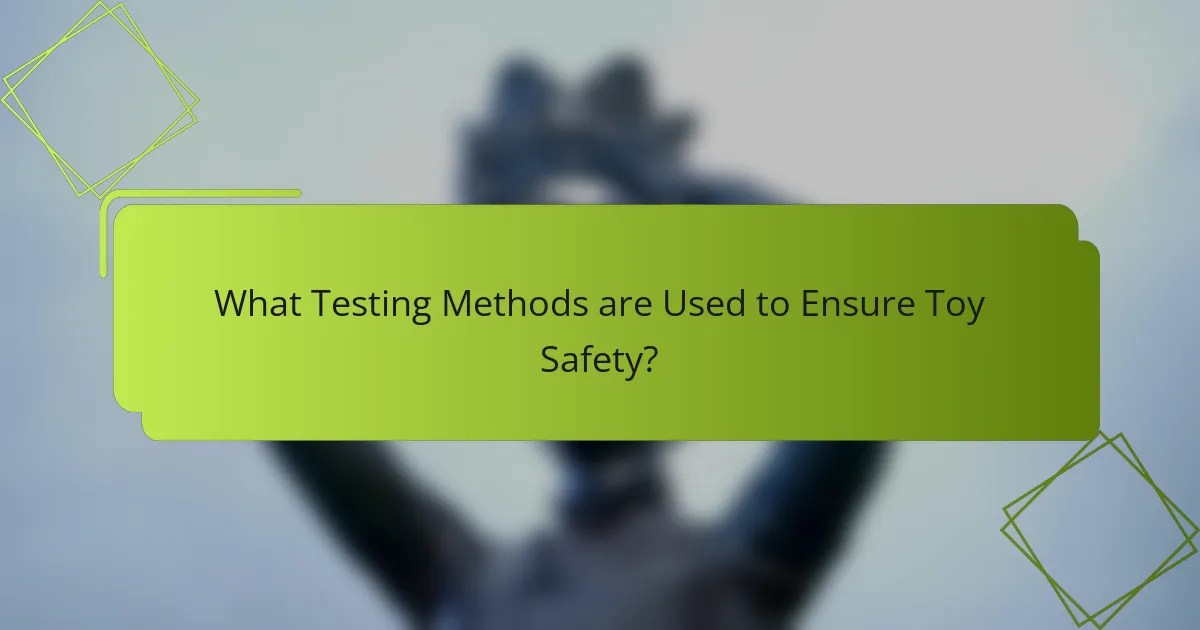
What Testing Methods are Used to Ensure Toy Safety?
Various testing methods are used to ensure toy safety. These methods include mechanical testing, chemical testing, and flammability testing. Mechanical testing assesses the physical properties of toys. It checks for sharp edges, small parts, and durability. Chemical testing evaluates the presence of harmful substances. Toys are tested for lead, phthalates, and other toxic materials. Flammability testing examines how toys react to fire. This ensures they meet safety standards for ignition and burning rates. Additionally, toys undergo age appropriateness testing. This determines if the toy is suitable for specific age groups. These testing methods help prevent injuries and ensure compliance with safety regulations.
How are Toys Tested for Safety Compliance?
Toys are tested for safety compliance through a series of standardized procedures. These procedures assess various aspects such as physical, mechanical, and chemical properties. Testing typically involves evaluating toys for hazards like sharp edges, choking risks, and toxic substances.
Regulatory bodies, such as the Consumer Product Safety Commission (CPSC) in the United States, establish safety standards for toys. Manufacturers must ensure that their products meet these standards before they can be sold.
Independent testing laboratories often conduct these assessments. They perform rigorous tests to check for compliance with safety regulations. The results are documented, and toys that pass are certified for safety.
Failure to meet safety compliance can result in recalls and legal penalties. This underscores the importance of thorough testing in ensuring consumer safety.
What are the common testing procedures for toys?
Common testing procedures for toys include mechanical safety tests, chemical analysis, and flammability tests. Mechanical safety tests assess the structural integrity and potential hazards of toys. These tests check for sharp edges, small parts, and choking hazards. Chemical analysis ensures toys do not contain harmful substances like lead or phthalates. Flammability tests evaluate how easily a toy ignites and how it burns. Compliance with standards such as ASTM F963 and EN71 is essential. These standards guide the testing processes to ensure toys are safe for children. Regular inspections and certifications help maintain safety in toy manufacturing.
How do laboratories ensure accurate testing results?
Laboratories ensure accurate testing results through strict adherence to standardized protocols. They implement quality control measures to monitor testing processes. This includes calibrating equipment regularly to maintain precision. Additionally, laboratories use validated methods that have been proven reliable through research. Staff are trained to follow procedures meticulously to avoid errors. They also participate in proficiency testing to benchmark their performance against other laboratories. Documentation of all procedures and results ensures traceability and accountability. These practices collectively enhance the reliability of test results in various applications, including safety standards in toy design.
What Role Does Certification Play in Toy Safety?
Certification ensures that toys meet specific safety standards. It verifies compliance with regulations set by organizations like ASTM International and the Consumer Product Safety Commission (CPSC). Certified toys undergo rigorous testing for hazards such as choking, sharp edges, and toxic materials. This testing process helps prevent unsafe products from reaching consumers. Certification also provides consumers with assurance about the safety of the toys they purchase. It promotes trust in brands that prioritize safety. Furthermore, certified toys are often subject to regular inspections to maintain compliance. This ongoing oversight enhances overall toy safety in the market.
What are the most recognized safety certifications for toys?
The most recognized safety certifications for toys include ASTM F963, EN71, and ISO 8124. ASTM F963 is the American standard for toy safety, established by the American Society for Testing and Materials. EN71 is the European standard that outlines safety requirements for toys sold in the European Union. ISO 8124 is an international standard that provides safety guidelines for toys globally. These certifications ensure that toys meet specific safety criteria, reducing the risk of injury to children. Compliance with these standards is essential for manufacturers to market their toys effectively and safely.
How can consumers verify a toy’s safety certification?
Consumers can verify a toy’s safety certification by checking for labels and documentation. Look for certification marks such as ASTM, EN71, or CE on the packaging. These marks indicate compliance with safety standards. Additionally, consumers can request safety test reports from manufacturers. Reputable companies provide access to these documents upon request. Online databases and regulatory agency websites also list certified toys. The U.S. Consumer Product Safety Commission (CPSC) maintains a database of recalled toys and safety standards. This information helps consumers make informed decisions regarding toy safety.
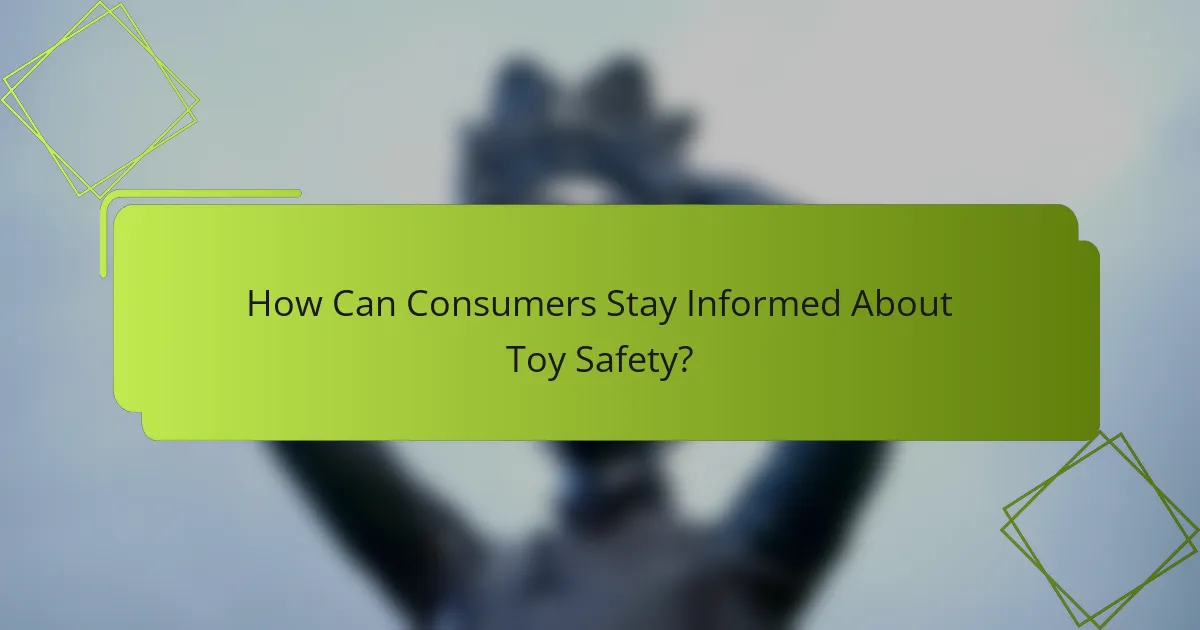
How Can Consumers Stay Informed About Toy Safety?
Consumers can stay informed about toy safety by regularly checking resources such as the Consumer Product Safety Commission (CPSC) website. The CPSC provides updates on toy recalls and safety standards. Additionally, consumers should read labels and safety warnings on toy packaging. This information often includes age recommendations and safety certifications. Following reputable parenting blogs and organizations can also offer insights on safe toys. Engaging with community groups focused on child safety can further enhance awareness. Lastly, attending workshops or webinars on toy safety can provide valuable knowledge.
What Resources are Available for Consumer Awareness?
Consumer awareness resources include government agencies, non-profit organizations, and educational materials. Government agencies like the Consumer Product Safety Commission (CPSC) provide safety guidelines and alerts. Non-profit organizations such as the American Academy of Pediatrics offer insights on safe toy choices. Educational materials include brochures and websites that inform consumers about safety standards. These resources help consumers make informed decisions regarding toy safety. Access to accurate information is crucial for ensuring children’s safety.
How can consumers access safety information about toys?
Consumers can access safety information about toys through several reliable sources. The U.S. Consumer Product Safety Commission (CPSC) provides a database of toy recalls and safety alerts. Manufacturers often include safety information on packaging and websites. Retailers may also offer safety guidelines for toys sold in their stores. Additionally, third-party organizations conduct safety tests and publish reports. Websites like Safe Kids Worldwide provide educational resources on toy safety. Parents should regularly check these sources to stay informed about potential hazards.
What organizations provide guidance on toy safety standards?
Organizations that provide guidance on toy safety standards include the American Society for Testing and Materials (ASTM), the Consumer Product Safety Commission (CPSC), and the International Organization for Standardization (ISO). ASTM develops and publishes voluntary consensus standards for toy safety. The CPSC enforces regulations to ensure toys are safe for children. ISO provides international standards that include safety requirements for toys. These organizations help establish safety protocols and guidelines to protect consumers.
What Steps Can Consumers Take to Ensure Toy Safety?
Consumers can ensure toy safety by following specific steps. First, they should check for safety certification labels. Look for labels from recognized organizations like ASTM or EN71. These certifications indicate compliance with safety standards. Second, consumers should read age recommendations on toy packaging. Toys designed for older children may pose choking hazards to younger ones. Third, they must inspect toys for small parts or sharp edges. These features can increase the risk of injury. Fourth, consumers should avoid toys with toxic materials. Check for labels indicating the absence of harmful substances like lead or phthalates. Fifth, staying informed about toy recalls is crucial. The Consumer Product Safety Commission (CPSC) regularly updates recall information. Lastly, consumers should supervise young children during play. Active supervision helps prevent accidents and injuries. By following these steps, consumers can significantly reduce the risk of toy-related injuries.
How can parents evaluate the safety of toys before purchase?
Parents can evaluate the safety of toys before purchase by checking for safety certifications. Look for labels like ASTM, EN71, or CE, which indicate compliance with safety standards. Research the manufacturer’s reputation and history regarding safety recalls. Read reviews from other consumers to assess their experiences. Inspect the toy for small parts that could pose choking hazards. Ensure the materials used are non-toxic and free from harmful chemicals. Familiarize yourself with age recommendations on toy packaging, as they are designed to prevent safety risks. Lastly, consider consulting resources like the Consumer Product Safety Commission for updated safety information.
What are the best practices for toy maintenance and safety checks?
Regularly inspect toys for wear and tear. Check for loose parts, sharp edges, or broken pieces. Clean toys frequently to remove dirt and germs. Use mild soap and water or disinfectant wipes. Ensure toys meet safety standards, such as ASTM or EN71. Store toys properly to prevent damage. Keep small toys out of reach of young children. Follow manufacturer instructions for care and maintenance. Replace any damaged toys immediately to ensure safety.
The main entity of this article is safety standards in toy design, which are essential regulations ensuring toys are safe for children. The article outlines the significance of these standards in minimizing injury risks, the various testing methods used to verify compliance, and the role of certification in promoting consumer trust. It also discusses the differences in regulations across countries, consumer awareness resources, and best practices for evaluating and maintaining toy safety. Key components such as mechanical and chemical testing, as well as labeling requirements, are highlighted to emphasize the importance of adhering to safety protocols in the toy industry.
